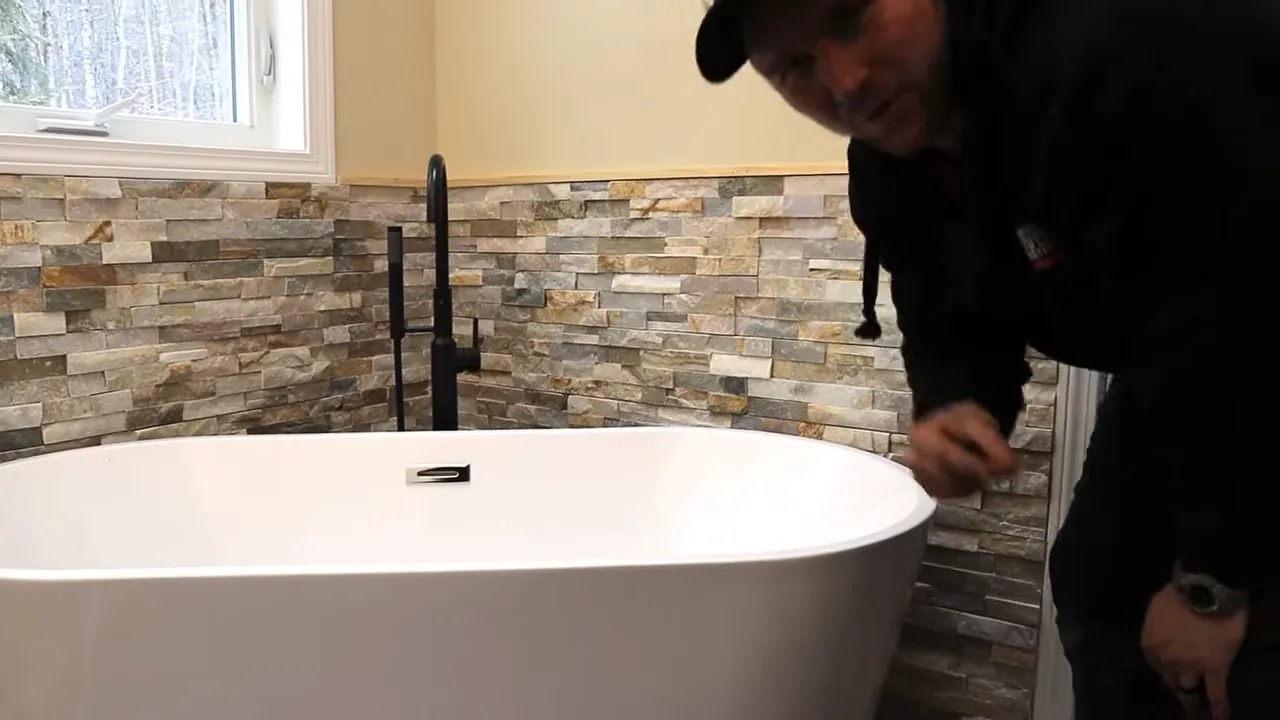Installing a freestanding jetted tub is a straightforward process that requires careful planning and preparation. First, make sure to select a suitable location for the tub and ensure the area meets the necessary electrical and plumbing requirements.
Then, follow the manufacturer’s instructions to assemble and connect the tub to the water supply and drainage system. Finally, test the tub for leaks and adjust the jets as needed. By following these steps, you can successfully install a freestanding jetted tub and enjoy a relaxing and soothing bathing experience in your own home.
Choosing The Right Freestanding Jetted Tub
Factors to consider when selecting a freestanding jetted tub
When it comes to choosing the right freestanding jetted tub for your bathroom, there are several factors that you should take into consideration. These factors will not only ensure that you select a tub that suits your needs and preferences, but also that the installation process goes smoothly. Before making a decision, keep the following factors in mind:
Different types of freestanding jetted tubs available
There are different types of freestanding jetted tubs available in the market, each offering its own set of features and benefits. Understanding these types will help you make an informed decision, based on your personal preferences and available space in your bathroom. Here are a few common types of freestanding jetted tubs:
1. Soaking tubs: These tubs are designed for deep and immersive baths, allowing you to fully submerge and relax. They are ideal for those who love to unwind in a warm bath after a long day.
2. Whirlpool tubs: Whirlpool tubs are equipped with multiple jets that create a swirling water massage effect. These tubs are perfect for those seeking a therapeutic and invigorating bathing experience.
3. Air tubs: Air tubs feature small jets that release streams of air bubbles into the water, providing a gentle and soothing massage. This type of tub is ideal for individuals who prefer a more subtle massage experience.
4. Combination tubs: As the name suggests, combination tubs offer the best of both worlds by combining the features of whirlpool and air tubs. With a combination tub, you can enjoy the benefits of both water and air jets.
Understanding the dimensions and installation requirements
Before purchasing a freestanding jetted tub, it is crucial to understand the dimensions and installation requirements. This will help you determine if the tub will fit into your bathroom and if any additional modifications are needed. Be sure to take accurate measurements of your bathroom space and consider factors such as doorways, windows, and plumbing fixtures.
Additionally, carefully review the manufacturer’s specifications for installation requirements. These specifications will outline the necessary plumbing connections, electrical requirements, and specific installation guidelines. It is important to adhere to these guidelines to ensure the tub functions properly and to prevent any potential damage.
By considering these factors when selecting a freestanding jetted tub, you can make an informed decision that suits your needs and preferences. Remember to carefully review the different types of tubs available and to understand the dimensions and installation requirements to ensure a successful installation process.
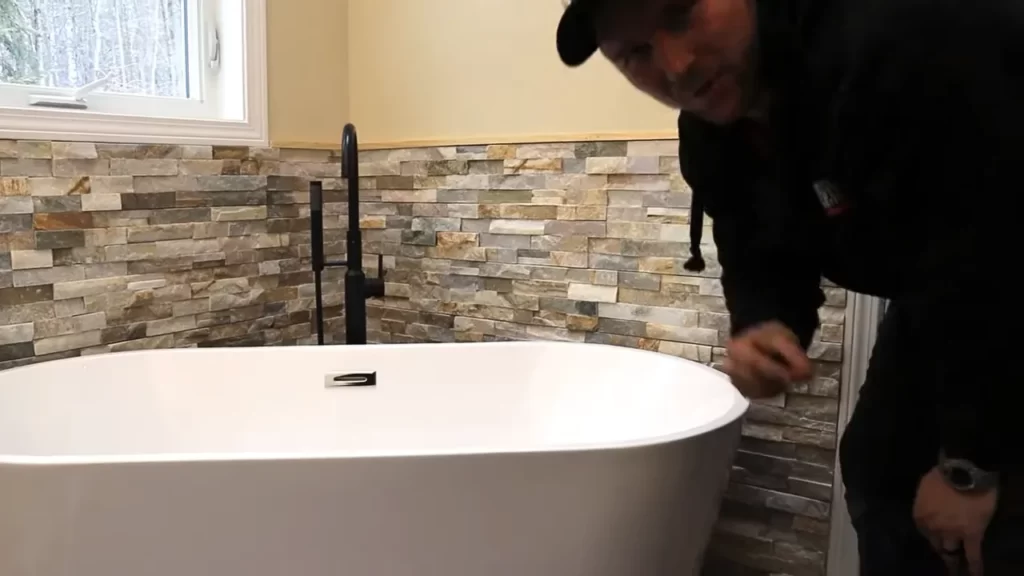
Measuring And Preparing The Bathroom Space
Installing a freestanding jetted tub can be a luxurious addition to any bathroom. Before diving into the installation process, it’s crucial to measure and prepare the bathroom space properly. This will ensure that the tub fits seamlessly and safely into the desired location. In this section, we will discuss how to measure the available space for the tub, assess the structural support, and prepare the plumbing and electrical connections.
Measuring the available space for the tub
Before purchasing a freestanding jetted tub, it’s essential to measure the available space in your bathroom accurately. The last thing you want is to invest in a tub that doesn’t fit! Here’s a step-by-step guide on how to measure the space:
- Start by clearing the area where you plan to install the tub. Remove any obstacles, such as cabinets or toilets, that might hinder the measurements.
- Use a tape measure to measure the length, width, and height of the designated area. Make sure to measure from the walls and not from any existing fixtures.
- Record the measurements carefully. It’s a good idea to take multiple measurements to ensure accuracy.
Once you have the measurements, you can begin searching for a freestanding jetted tub that fits perfectly into your bathroom space.
Assessing the structural support for the tub
Freestanding jetted tubs can be heavy, especially when filled with water and occupied by individuals. To ensure the safety and stability of the tub, it’s crucial to assess the structural support in your bathroom. Follow these steps to assess the support:
- Inspect the floor beneath the intended installation area. Ensure that it can support the weight of the tub, water, and occupants. If you have any doubts, consult a professional contractor.
- Consider the location of the tub in relation to the floor joists. If possible, align the tub with the joists for added support.
- Check the wall structure around the tub area. Look for any signs of damage or weakness that may affect the installation.
By assessing the structural support, you can prevent any unfortunate accidents or damages that may occur due to an unsuitable installation area.
Preparing the plumbing and electrical connections
Before installing a freestanding jetted tub, you’ll need to ensure that the plumbing and electrical connections are prepared correctly. Here are the steps to get everything ready:
- Consult a professional plumber and electrician to ensure compliance with local regulations and safety standards.
- Plan the plumbing and electrical connections based on the specific requirements of the tub you have chosen. This may include installing appropriate pipes, drains, and wiring.
- Ensure that the water supply and electrical outlets are easily accessible near the installation area.
By preparing the plumbing and electrical connections in advance, you can save time and avoid any unexpected complications during the installation of your freestanding jetted tub.
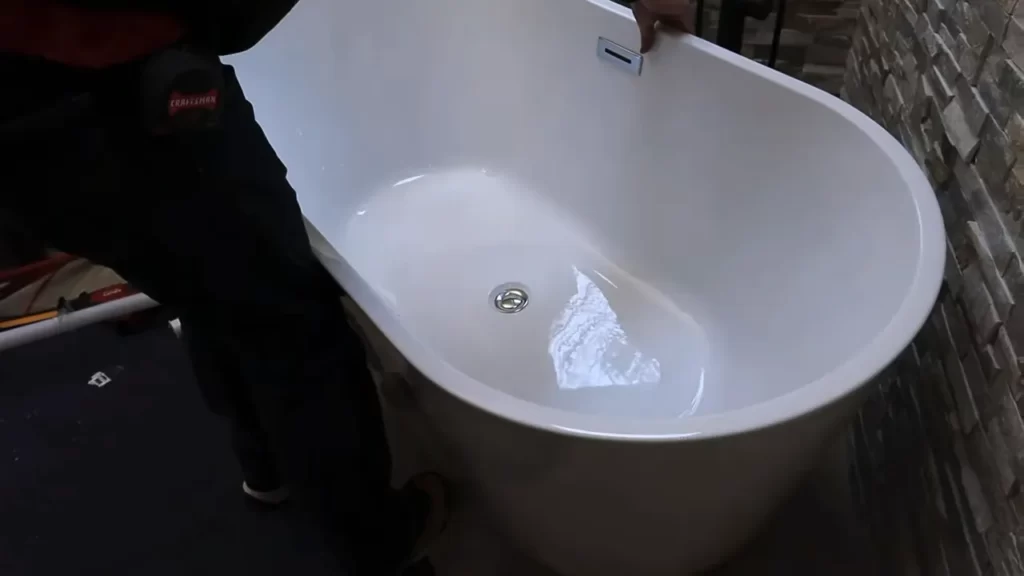
Installing The Freestanding Jetted Tub
Installing a freestanding jetted tub can add a touch of luxury and relaxation to your bathroom. With the right tools and a bit of know-how, you can transform your bathroom into a spa-like retreat. In this blog post, we will guide you through the process of installing a freestanding jetted tub, from positioning the tub in the bathroom all the way to securing it in place and leveling it.
Positioning the Tub in the Bathroom
The first step in installing a freestanding jetted tub is to position it in the bathroom. This requires careful planning and measurement to ensure a proper fit. Follow these steps to position the tub:
- Measure the dimensions of the tub and the available space in your bathroom.
- Clear the area where the tub will be placed, making sure there are no obstacles or obstructions.
- With the help of another person, carefully lift the tub and place it in the desired location.
- Adjust the position of the tub, ensuring that it is centered and aligned with the surrounding fixtures.
Connecting the Plumbing and Electrical Components
Once the tub is in position, the next step is to connect the plumbing and electrical components. Here’s how you can do it:
- Locate the water supply lines and drain pipes in your bathroom.
- Connect the tub’s drain to the drain pipe, ensuring a secure and watertight connection.
- Attach the tub’s water supply lines to the corresponding hot and cold water supply pipes.
- If your freestanding jetted tub has electrical components, such as jets or lights, consult the manufacturer’s instructions for proper electrical connections.
Securing the Tub in Place and Leveling It
Once the plumbing and electrical components are connected, the final step is to secure the tub in place and ensure it is level. Follow these steps to complete the installation:
- Use a level to check if the tub is perfectly level. If it is not, adjust the tub’s feet or use shims to achieve a level position.
- Secure the tub to the floor or subfloor using the provided hardware, following the manufacturer’s instructions.
- Check for any movement or instability by applying pressure to different areas of the tub. If there is movement, make further adjustments to ensure the tub is securely in place.
With these steps completed, you have successfully installed your freestanding jetted tub. Now you can sit back, relax, and enjoy the soothing jets right in the comfort of your own bathroom.
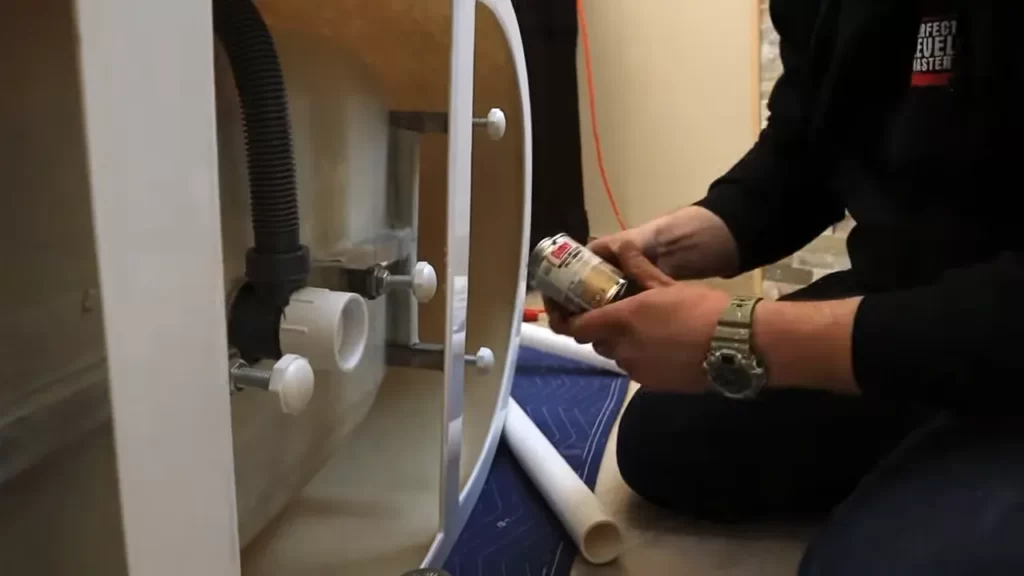
Testing And Troubleshooting
Once you have successfully installed your freestanding jetted tub and ensured that all the connections are secure, it’s time to test and troubleshoot any potential issues. This step is crucial to ensure that your tub is in proper working condition and to address any problems before they become major headaches.
Filling the tub with water and checking for leaks
The first step in testing your freestanding jetted tub is to fill it with water and check for any leaks. Follow these simple steps:
- Close all drain stoppers and faucets.
- Fill the tub with water, making sure to reach the appropriate water level indicated by the manufacturer.
- As the tub fills, inspect all the connections for any signs of leaks. Pay close attention to the areas where pipes and fittings are joined.
- If you notice any leaks, tighten the connections using a proper wrench or consult a professional if necessary.
- Once the tub is filled, let it stand for a few minutes and observe if any water is seeping out. This will help you identify any hidden leaks.
Testing the jets and adjusting the settings
After confirming that there are no leaks, you can proceed to test the jets and adjust their settings to your preference. Here’s how:
- Turn on the jets by using the control panel or the designated buttons.
- Ensure that each jet is performing as expected and producing a strong, steady stream of water.
- Check if the direction and intensity of the jets can be adjusted according to your liking.
- If any of the jets are not functioning properly or if the water flow is weak, check for any blockages in the jets or the plumbing.
- Refer to the manufacturer’s manual for specific instructions on adjusting the jet settings to achieve your desired massage experience.
Troubleshooting common installation issues
Even with careful installation, certain issues may arise. Here are some common installation issues and troubleshooting tips:
| Issue | Troubleshooting |
|---|---|
| Low water pressure | Check for any clogs or restrictions in the water supply lines. If necessary, consult a plumber to optimize the water pressure. |
| Water temperature fluctuations | Ensure that the water heater is in good working condition and set to a consistent temperature. Insulate exposed pipes to prevent temperature fluctuations. |
| Noisy operation | Inspect the motor and pump for any loose connections or faulty components. Lubricate moving parts if necessary. Consider contacting a professional if the noise persists. |
| Error codes on the control panel | Refer to the manufacturer’s manual to understand the meaning of the error codes. Take appropriate action as instructed to resolve the issue. |
By following these testing and troubleshooting steps, you can ensure that your freestanding jetted tub is properly installed and functioning optimally. Enjoy the luxurious and relaxing experience that your new tub provides!
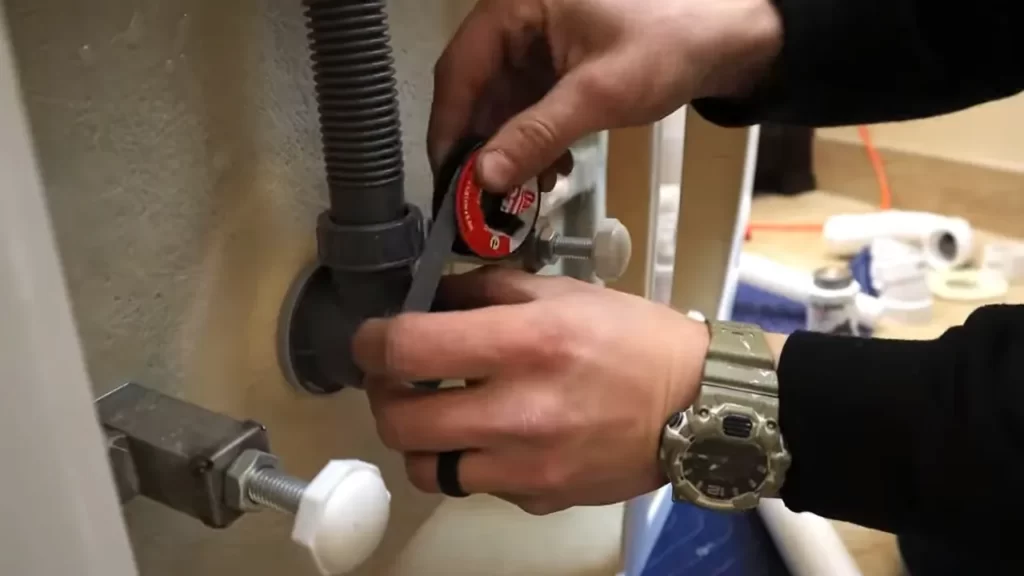
Care And Maintenance Of The Freestanding Jetted Tub
Once you have successfully installed your freestanding jetted tub, it’s important to understand the necessary care and maintenance to keep it clean, functional, and enjoyable for years to come. In this section, we will discuss the key aspects of caring for and maintaining your jetted tub, including cleaning and sanitizing the tub regularly, proper maintenance of the jets and filters, and tips for prolonging the lifespan of the tub. By following these guidelines, you can ensure that your freestanding jetted tub remains a relaxing oasis in your bathroom.
Cleaning and sanitizing the tub regularly
To maintain a clean and hygienic jetted tub, regular cleaning and sanitizing are essential. Here are some simple steps to follow:
- Drain the water from the tub after each use to prevent the growth of bacteria.
- Fill the tub with warm water, ensuring that the water level is above the jets.
- Add a jetted tub cleaner or a mixture of mild dish soap and warm water to the tub.
- Run the jets for about 15 minutes to allow the cleaner to circulate through the system.
- Drain the water from the tub and rinse it thoroughly.
- Wipe down the surface of the tub with a soft cloth or sponge to remove any residue.
- Repeat this cleaning process at least once a month or as needed.
Regular cleaning and sanitizing will not only remove any buildup or impurities from the tub but also help maintain the functionality of the jets.
Proper maintenance of the jets and filters
In addition to regular cleaning, it’s important to properly maintain the jets and filters of your freestanding jetted tub. Here’s what you need to do:
- Remove and clean the filter regularly, following the manufacturer’s instructions.
- Inspect the jets for any signs of debris or blockages.
- If necessary, use a soft brush or toothbrush to gently scrub the jets and remove any buildup.
- Regularly check the water intake and drainage system for any obstructions.
- Refer to the manufacturer’s guidelines for specific maintenance recommendations, as different tub models may have unique requirements.
By taking proper care of the jets and filters, you can ensure that your jetted tub operates at its optimal performance and provides you with the utmost relaxation.
Tips for prolonging the lifespan of the tub
To prolong the lifespan of your freestanding jetted tub and maintain its functionality for years to come, consider the following tips:
- Avoid using harsh chemicals or abrasive cleaners that could damage the tub’s surface or internal components.
- Keep the tub covered when not in use to prevent dust, debris, and unwanted particles from entering the water and clogging the jets or filters.
- Regularly inspect the tub’s seals and connections to ensure there are no leaks or potential areas of damage.
- Use the tub according to the manufacturer’s guidelines and avoid exceeding the recommended water capacity or jet operation time.
- Consider using a water softener to prevent mineral buildup and protect the tub’s components.
By following these tips and guidelines, you can enjoy your freestanding jetted tub for many years while minimizing the need for repairs or replacements.
Additional Considerations And Safety Precautions
When it comes to installing a freestanding jetted tub, it is essential to not only focus on the functionality and aesthetics but also on the safety aspects of the installation. There are several additional considerations and safety precautions that you need to keep in mind to ensure a safe and enjoyable experience. In this section, we will discuss three important factors to consider: ensuring proper ventilation in the bathroom, following safety guidelines for electrical connections, and considering accessibility features for individuals with disabilities.
Ensuring proper ventilation in the bathroom
Proper ventilation is crucial when installing a freestanding jetted tub. The high humidity levels and steam generated by the tub can lead to moisture buildup and the growth of mold and mildew. To prevent this, ensure that your bathroom has adequate ventilation. You can achieve this by installing a vent fan that is specifically designed for high humidity areas. The fan will help remove excess moisture from the air, improving air quality and preventing any potential damage caused by prolonged exposure to humidity.
Following safety guidelines for electrical connections
Electrical safety is of utmost importance when installing a freestanding jetted tub. Improper electrical connections can pose serious risks, including electrical shock and fire hazards. Before starting the installation, it is highly recommended to consult a licensed electrician who can ensure that all electrical connections meet the necessary safety standards. Additionally, make sure that the tub is grounded properly to minimize the risk of electrical accidents. An electrical safety inspection should be conducted to identify any potential issues and ensure compliance with electrical codes.
Considering accessibility features for individuals with disabilities
When installing a freestanding jetted tub, it is important to consider accessibility features for individuals with disabilities. This includes providing adequate space around the tub for wheelchair accessibility and installing grab bars for stability and support. The tub should have easy-to-reach controls and a comfortable seating position for individuals with limited mobility. By incorporating these accessibility features, you can ensure that everyone can enjoy the benefits of a jetted tub in a safe and inclusive environment.
Frequently Asked Questions
What Holds A Freestanding Tub In Place?
The weight of a freestanding tub is supported by a structural base or platform. Additionally, some tubs may have adjustable feet for added stability.
Can You Have A Freestanding Tub With Jets?
Yes, it is possible to have a freestanding tub with jets. This type of tub provides the luxurious experience of a freestanding tub along with the added benefit of soothing jet massages. Jets can be installed in a variety of freestanding tub models for a relaxing and invigorating bathing experience.
Are Freestanding Tubs Hard To Install?
Freestanding tubs are not hard to install. Just follow the instructions carefully and use the right tools.
How Hard Is It To Install A Jetted Tub?
Installing a jetted tub can be challenging. It requires professional guidance and plumbing expertise due to the complex installation process. It’s essential to ensure proper electrical connections and structural support for the tub. Consulting with a professional can ensure a safe and successful installation.
Conclusion
Installing a freestanding jetted tub can be a rewarding project that adds luxury and relaxation to your bathroom. By following the step-by-step guide provided in this blog post, you can successfully install your tub and enjoy the therapeutic benefits it offers.
Remember to prioritize safety, measure accurately, and connect the necessary plumbing and electrical components. With careful planning and attention to detail, you can create a spa-like retreat in your own home. Happy tub installation!
